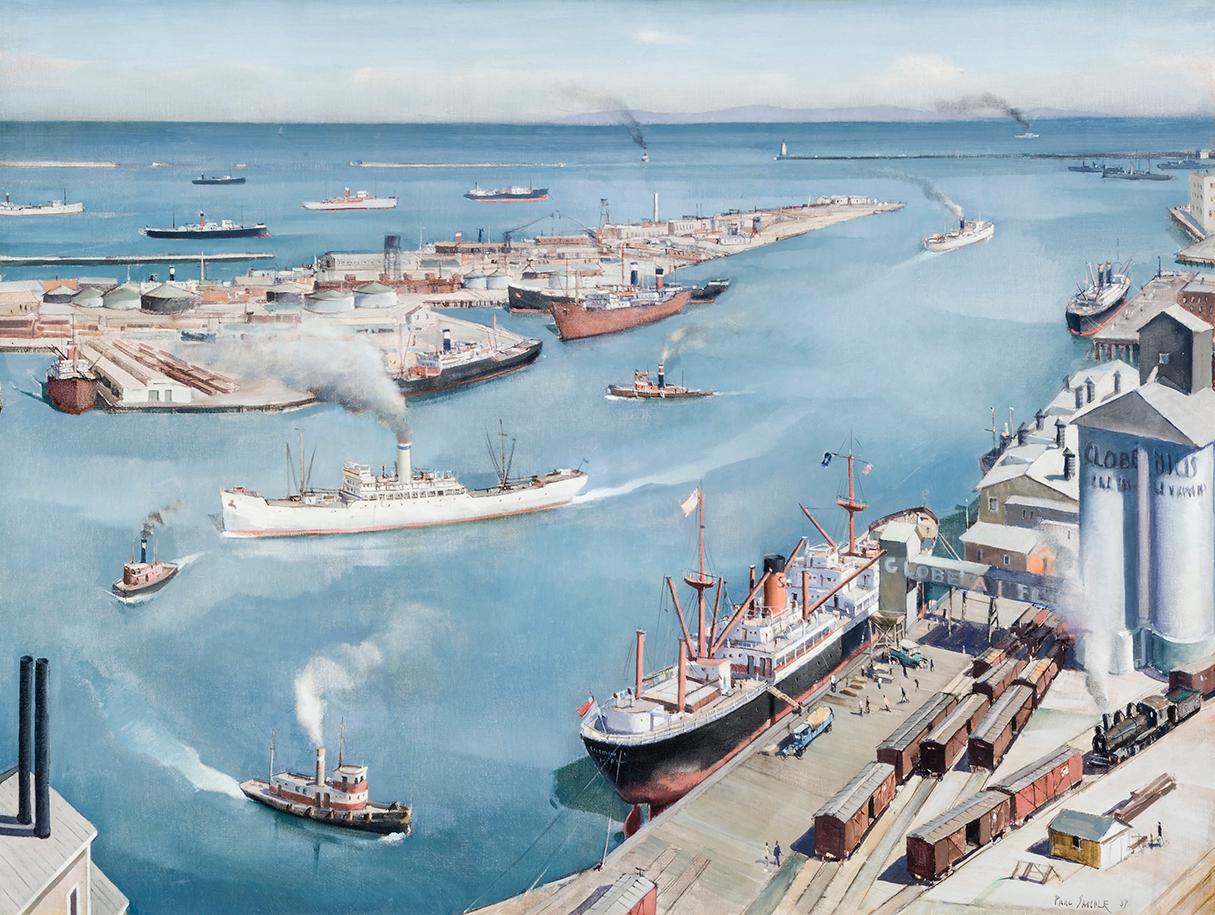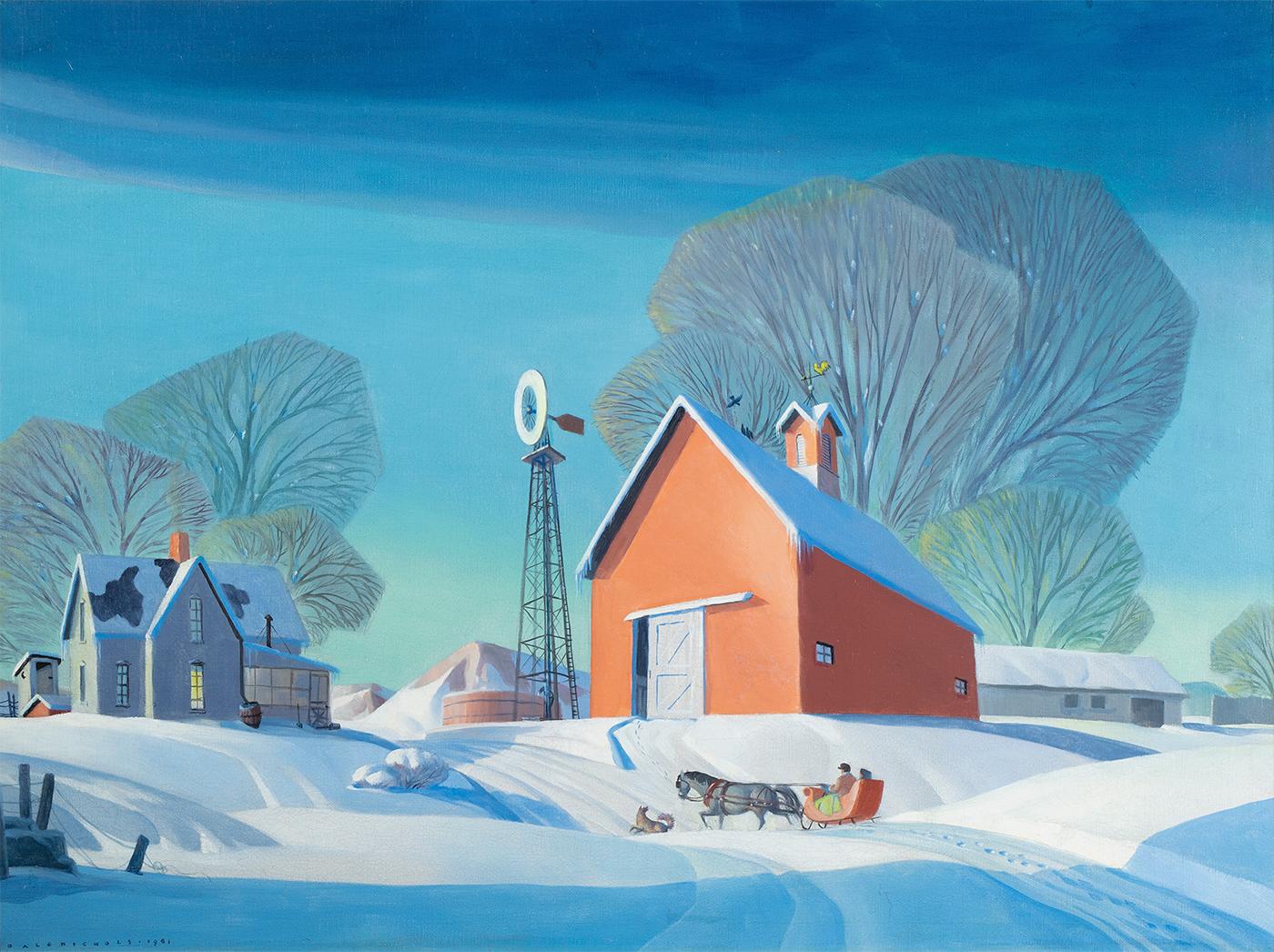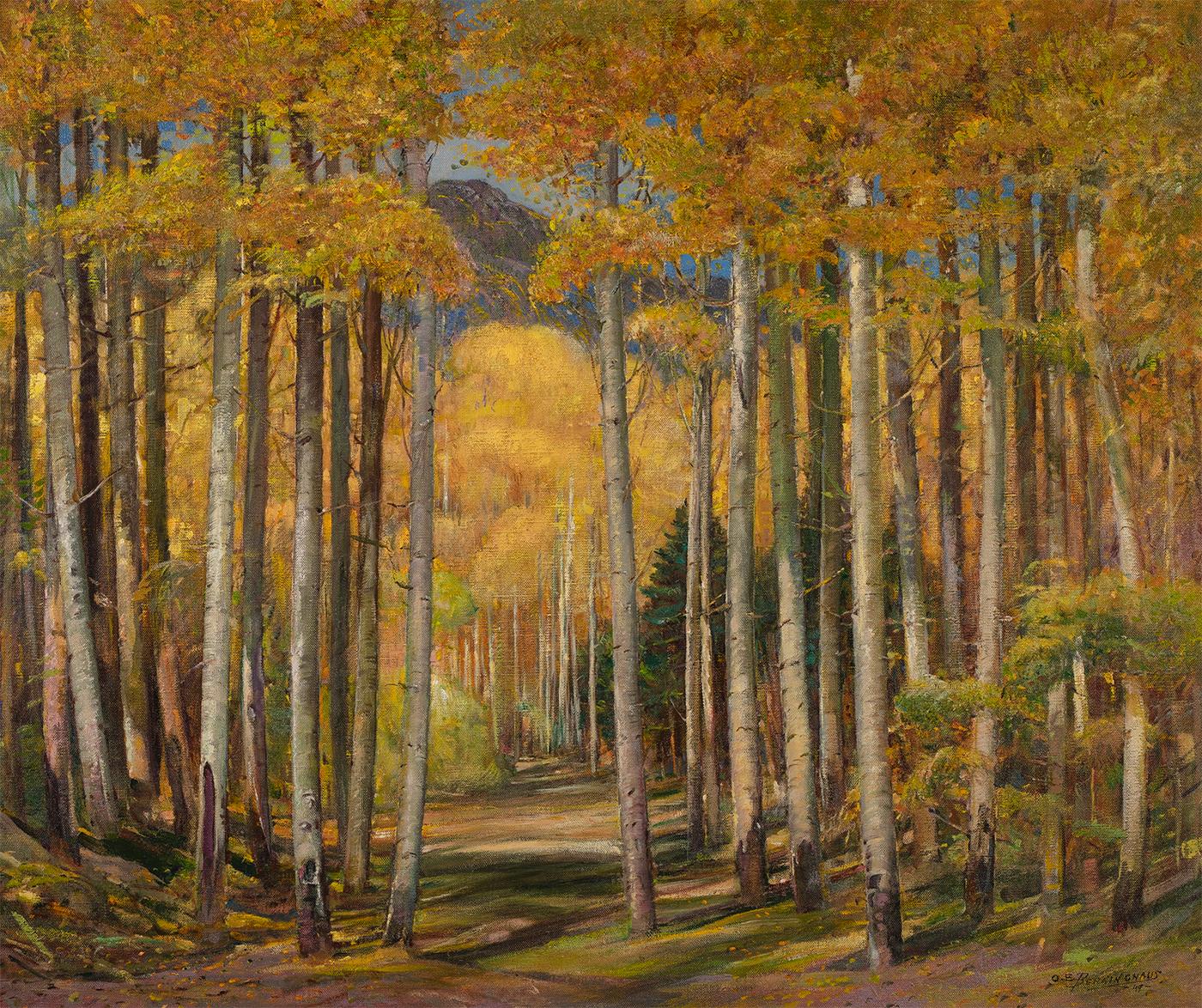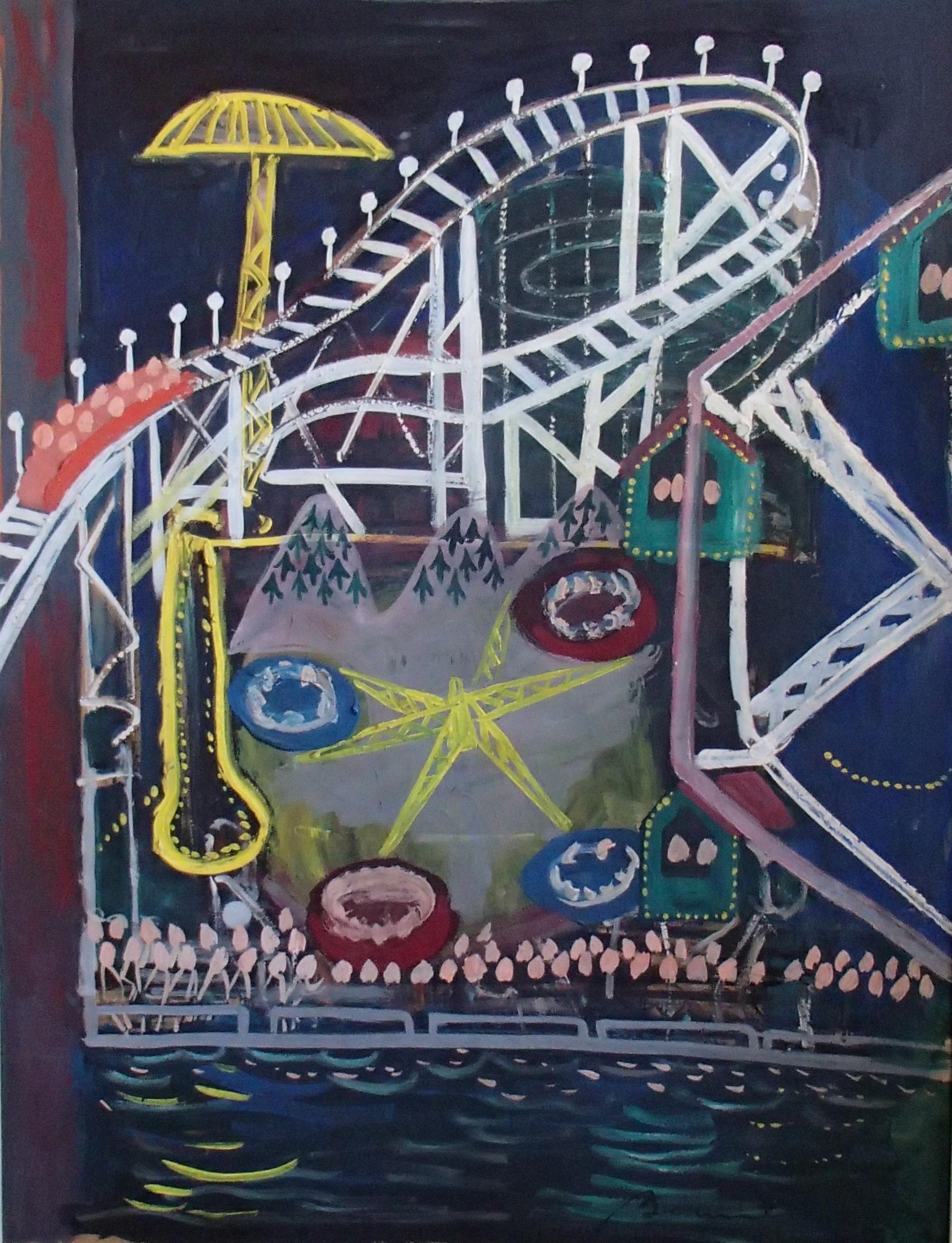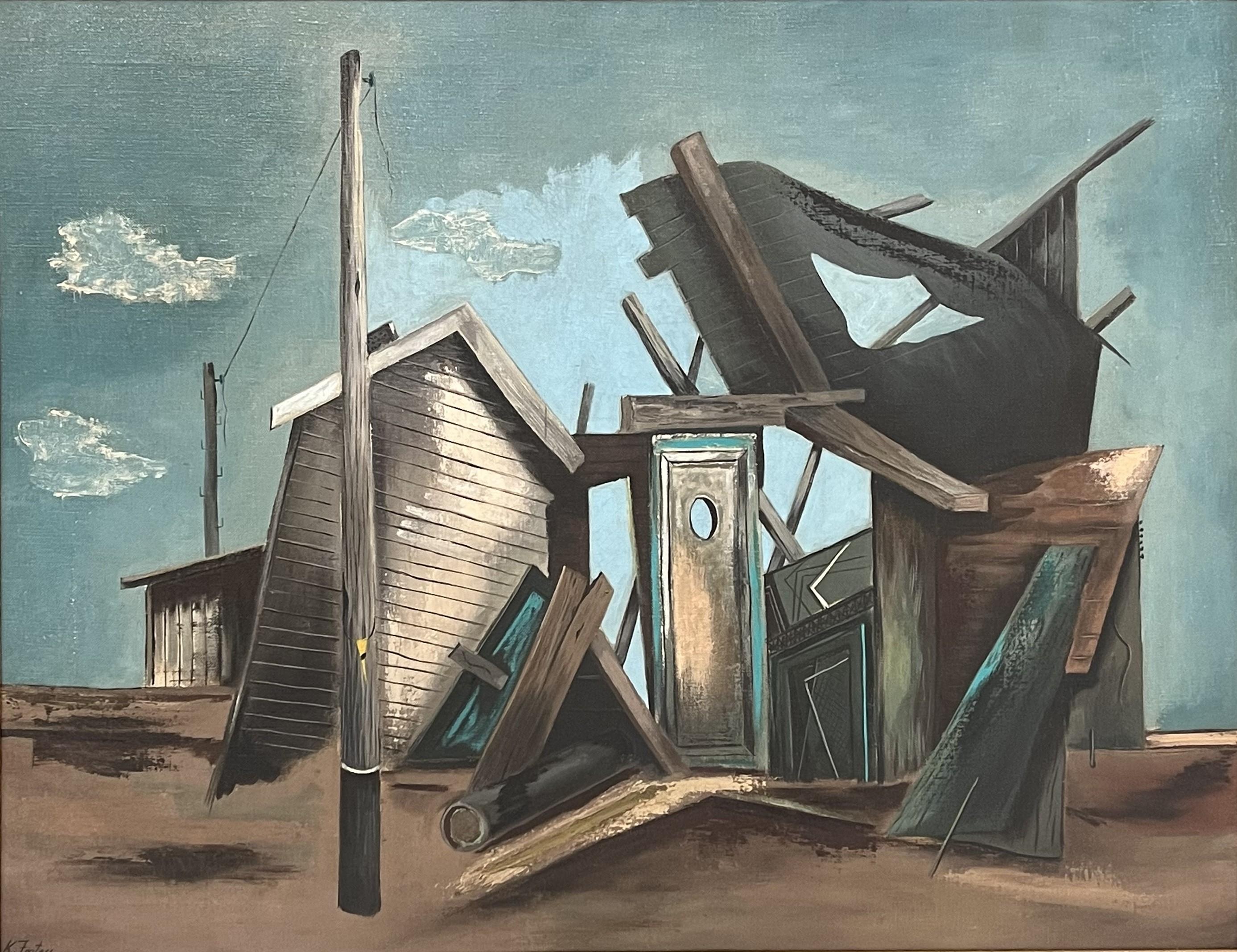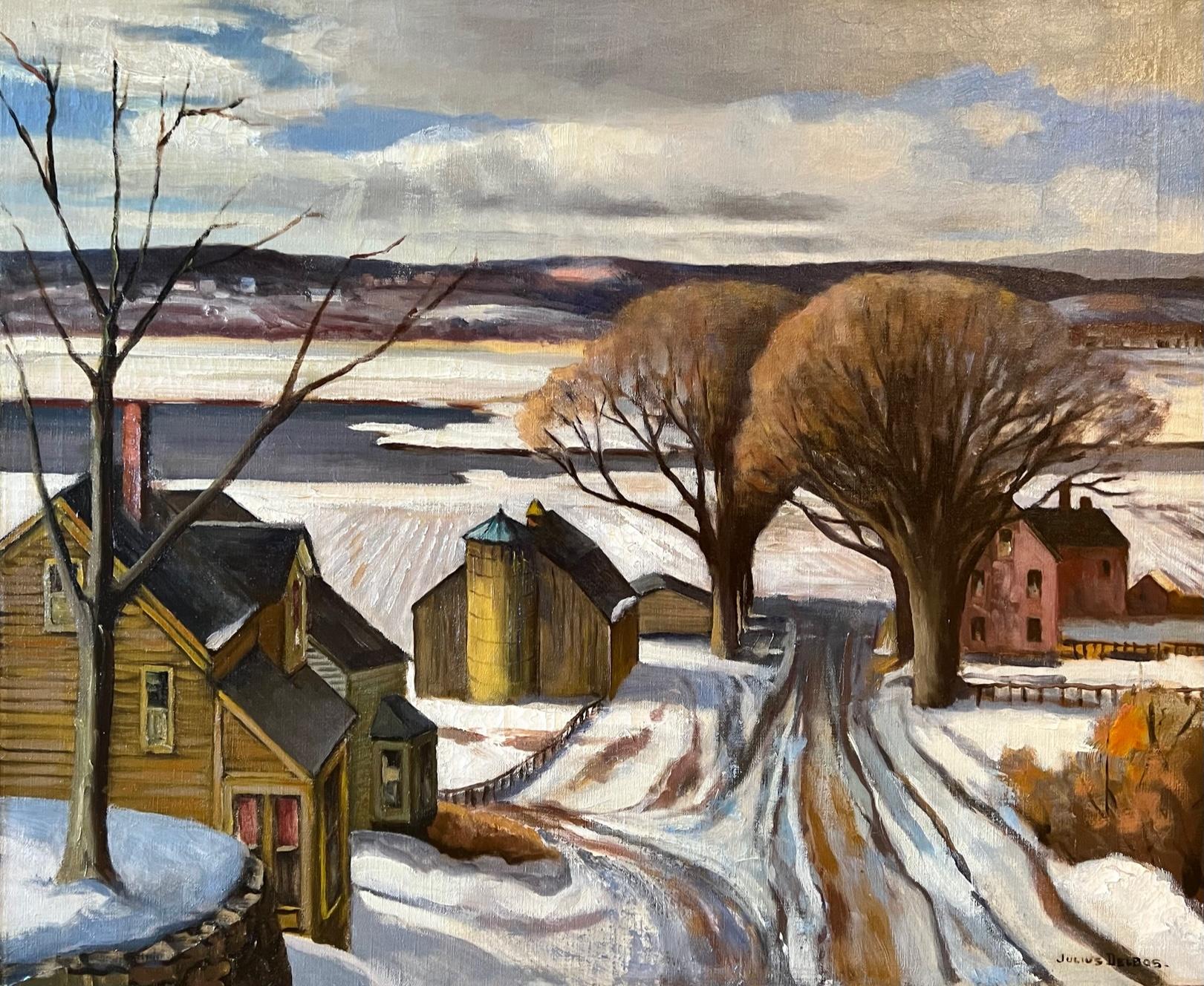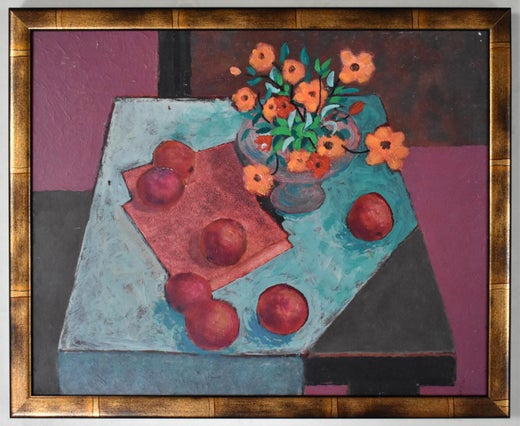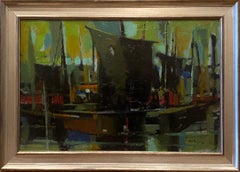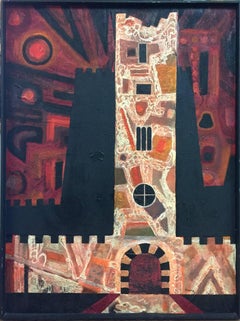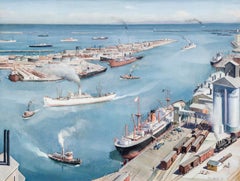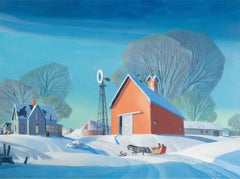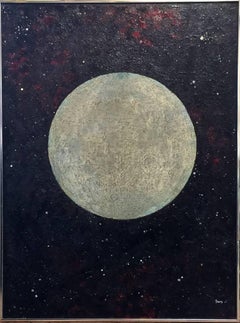
"The Moon Party" Mid Century Modern Texas Painting Oil Heavy impasto
View Similar Items
Michael Frary"The Moon Party" Mid Century Modern Texas Painting Oil Heavy impastoCirca 1960
Circa 1960
About the Item
- Creator:Michael Frary (1918-2005, American)
- Creation Year:Circa 1960
- Dimensions:Height: 41 in (104.14 cm)Width: 31 in (78.74 cm)Depth: 4 in (10.16 cm)
- Medium:
- Movement & Style:
- Period:
- Condition:Please view my 1stdibs store front for other Great Vintage Texas Paintings & Fine American Art. We carry Vintage, Mid Century & Contemporary.
- Gallery Location:San Antonio, TX
- Reference Number:1stDibs: LU76932521971
Michael Frary
Michael Frary was born in Santa Monica, California on May 28, 1918. His father died when Michael was six months old. Relatives from the east moved him, his mother and siblings from California to Florida. He graduated from Palm Beach High School in 1934 and returned to California where he accepted a swimming scholarship from the University of Southern California. During his time at USC, he became a champion swimmer and captain of the USC varsity water polo team. In 1940, he graduated with a bachelor of architecture degree and a master of fine arts in painting the following year. At the outbreak of World War II, Fraryjoined the United States Navy, eventually receiving his discharge as Lieutenant at the war's conclusion in 1945. Upon his return to California, he became assistant art director first for the Goldwyn Studios, Paramount and then finally Universal Studios. His hectic lifestyle, although glamorous, did not allow him enough time to pursue his love of painting. To fulfill this need Frary began teaching night classes in painting. Shortly thereafter UCLA offered a full-time teaching position and he made a permanent break from art director to painting instructor. During his teaching career in California, Frary also taught at Los Angeles City College and the Chouinard Art Institute.
In 1949, Frary moved to Texas to serve as the artist in residence and faculty chairman for the irrepressible Marion Koogler McNay in San Antonio. He taught at her burgeoning art school for several seasons. It was during this time in San Antonio that he met Peggy Mathewson who he married in 1950. He accepted a teaching position as an assistant professor with the University of Texas at Austin, which named him Professor of Art in 1970 and upon his retirement from teaching in 1986 he was named Professor Emeritus of Art. Frary’s artwork and love for the state in which he lived for more than half a century resulted in the publication of three books: Impressions of the Big Thicket, University of Texas Press, 1973, Impressions of the Texas Panhandle, Texas A&M University Press, 1977 and Watercolors of the Rio Grande, Texas A&M University Press, 1984. Through his writing and watercolors, these books vividly convey the breadth and scope of the land that provided his inspiration. In pursuit of this inspiration, Frary and his wife, Peggy also traveled across the United States, South America, South Africa, England, Mexico, Italy and France.
During his career, Frary received over 175 awards and purchase prizes and earned over 200 one-man exhibitions. During his career spanning almost 70 years, Frary influenced the course of art, not only in Texas, but in the United States as well. He was a seminal figure in the art movement known as modernism and with his contemporaries on the faculty of the Art Department at the University of Texas, he changed the face of art on a national scale. Now widely celebrated as a Texas Modernist, Frary’s influence has also shaped the lives and careers of the countless thousands of students whom he taught both in a classroom setting and through hundreds of watercolor seminars and workshops throughout the southwest. Frary’s works are housed in 100s of private and public collections worldwide including the National Museum of American Art, Smithsonian Institute, the Los Angeles County Museum, the Santa Barbara Museum of Art, the Virginia Scott Museum, Pasadena. His works are also housed in The Springfield Museum of Art, the Virginia Museum of Fine Arts, the Phillips Petroleum Building, the Dallas Museum of Fine Art, the Panhandle-Plains Museum, Museum of the Big Bend, the Amarillo Art Center, McNay Art Museum, the Texas Instruments Collection, the Austin Museum of Art and the University of Texas at Austin.
Frary also received many important commissions, which included, among others, the selection of his painting, Antelope Country by the National Gallery for presentation by President and Mrs. Lyndon B. Johnson to the New Zealand Prime Minister and his wife at the Manila Conference. He was also commissioned in 1972 by the U.S. Department of Interior to paint at reclamation sites in four states, resulting in four of his paintings being shown at an exhibition at the National Gallery. In 1974, the Austin Chapter of the American Institute of Architects awarded Frary the Medal of Honor and the Texas Society of Architects presented him with the Citation of Honor, both in recognition of his book Impressions of The Big Thicket. In 1978, he was commissioned to paint the Psyche Prize for the Fourth Biennial International Film Festival of Canada. Frary died on Tuesday, August 30, 2005.
- "GREEN BOATS" OTIS DOZIER 1960 MCM ABSTRACT MID CENTURY MODERNBy Otis DozierLocated in San Antonio, TXOtis Dozier (1904 - 1987) Dallas Artist Image Size: 20 x 30 Frame Size: 25 x 35 Medium: Oil Dated 1960 Biography Otis Dozier (1904 - 1987) Otis Marion Dozier is noted as a member of a group of Texas regionalist artists known as the "Dallas Nine". His style was characterized by brilliant colors and strong forms, often focusing on the plight of farmers affected by the Great Depression. Dozier was born in Forney, Texas in 1904. Raised on a farm in Mesquite, Texas with three siblings, his surroundings provided the materials that allowed him to cultivate a love for nature and wildlife. He once said, "youve got to start from where you are and hope to get to the universal." His surroundings became a primary focus for subject matter in his art. Other areas providing inspiration for his works would include the Big Bend and Gulf Coast areas of Texas, the Four Corners area of New Mexico, Arizona, and Utah, and the bayous and swamps of Louisiana. His earliest art training was in Dallas from Vivian Aunspaugh, Cora Edge, and Frank Reaugh when his family moved there in the early 1920s. Dozier became a member of the Dallas Artists League in the 1930s after becoming involved with a group of regionalist artists. He taught at the Dallas School of Creative Arts from 1936 to 1938, while at the same time studying the various works of European artists such as Picasso, Leger, and Matisse. His initial style included bright colors and dominant forms but later moved to the earthy tones of beige, green, brown, and gray. In 1940, Dozier married and together he and his wife contributed much to the Dallas cultural scene. Dozier attended the Colorado Springs Fine Arts Center in 1938 on a scholarship, studying with Boardman Robinson. For the next seven years he served as Boardmans assistant. While in Colorado, the Rocky Mountains became a favorite painting ground where he completed more than 3000 sketches of ghost towns and mountains. Influenced by Robinson, he developed a more fluid style and became an expert in the lithographic medium. Upon returning to Dallas, Dozier taught life drawing at Southern Methodist University from 1945 to 1948. From 1948 until 1970 he taught drawing and painting at the Dallas Museum of Fine Arts. He participated in sole exhibitions in the early to mid 1940s, as well as other major exhibitions at the Whitney Museum of American Art and the Metropolitan Museum of Art in New York City. Dozier completed murals at the Agricultural and Mechanical College of Texas (Texas A&M University) and at various post offices in Texas. He won many awards at various exhibitions, including the International Watercolor Exhibition in San Francisco in 1932; the Museum of Modern Art in New York in 1933; the First National Exhibition in New York in 1936; Allied Arts exhibitions in 1932, 1935, and 1947; and two Texas General exhibitions in 1946 and 1947. His works may be found in the permanent collections of the Museum of Fine Arts in Houston; the Archer M. Huntington Art Gallery at the University of Texas at Austin; the Modern Art Museum of Fort Worth; the Marion Koogler McNay Art Museum in San Antonio; the Dallas Museum of Art; and the Panhandle-Plains Museum in Canyon, among others. Dozier died of heart failure in 1987. Additional exhibition venues: Otis Dozier: A Centennial Celebration 1904-1987 The McKinney Avenue Contemporary, November 6 - December 10, 2004 OTIS DOZIER (1904-1987) Otis Dozier was born in Forney, Texas in 1904 and was raised on a farm in nearby Mesquite. Dozier enjoyed drawing and painting from an early age, and a visit to the Texas State Fair convinced him to pursue art as a vocation. Dozier recalled visiting the Fair’s rotunda and, there, seeing an early work by Mexican muralist Diego Rivera. Dozier did not understand the image but was fascinated by it, later recalling that looked like blood and buttermilk to him; he just looked and looked; the newspaper said it was so great and he was willing to learn but couldn’t understand why it was so great. Dozier’s family moved to Dallas at the beginning of the 1920s, and it was there that he would receive artistic training under Vivian Aunspaugh, Cora Edge, and Frank Reaugh. Dozier would study with Aunspaugh for two years. She introduced Dozier to art history and spoke highly of the Impressionists, although she was cooler towards the Cubists and Fauvists who represented France’s new vogue. Dozier became a member of the Dallas Artists League in the 1930s. He taught at the Dallas School of Creative Arts from 1936 to 1938 and was a significant member of the burgeoning Dallas art scene. Otis Dozier was a member of the cadre of Dallas artists known as the “Dallas Nine.” Though the disparate group of painters, printmakers and sculptors who composed the Nine could be broadly categorized as regionalists, they often displayed a decided fascination with the European avant-garde. This is especially true of Otis Dozier’s works, in which regionalist subject matter was often mingled with Surrealist and Cubist techniques. Starting in 1936, Dozier—as well as the other members of the Dallas Nine—began exhibiting their work at local, regional and national exhibitions. In 1936, Dozier, along with 713 artists from 47 states, attended the First National Exhibition of American Art at Rockefeller Center in New York. Dozier himself participated in numerous solo exhibitions during the mid-1940s and contributed to exhibitions in New York’s Whitney Museum of American Art and Metropolitan Museum of Art. In 1945, Dozier returned to Dallas. He had been invited by fellow artist Jerry Bywaters...Category
1960s Modern Landscape Paintings
MaterialsOil
- "Cactus Skull"By Ernesto PachecoLocated in San Antonio, TXErnesto Pacheco Image Size: 48 x 36 Frame: 55.5 x 43 Medium: Oil "Deer Horns" Exquisite. Explosion of brilliant colors to include pink, blue, green, purple, lavender, etc.Category
1980s Modern Landscape Paintings
MaterialsOil
- "Victoria Tower England" Mid Century Modern Texas Painting OilBy Michael FraryLocated in San Antonio, TXMichael Frary (1918 - 2005) Austin Artist Image Size: 40 x 30 Frame Size: 41 x 31 Medium: Heavy Textured Acrylic 1966 "Victoria Tower" Biography Michael Frary (1918 - 2005) M...Category
1960s Modern Landscape Paintings
MaterialsOil
- "Trees" The 1st Texas Black Woman allowed to exhibit in a Juried Art show.By Rezalia ThrashLocated in San Antonio, TXRezalia Thrash (1893 - 1982) Dallas Artist Image Size: 24 x 30 Frame Size: 30 x 36 Medium: Oil "Trees" Biography Rezalia Thrash (1893 - 1982) Rezalia C Thrash was the first ...Category
1960s Modern Landscape Paintings
MaterialsOil
- "Oil Derrick" Boomtown Bust RegionalistLocated in San Antonio, TXE. Scholz Texas Artist Image Size: 22 x 30 Frame Size: 29 x 37 Medium: Oil 1948 Texas Regionalism at its finest.Category
1940s Modern Landscape Paintings
MaterialsOil
- "Strange Storm Coming" Sail Boats, Mid Century Modern Texas PaintingBy Michael FraryLocated in San Antonio, TXMichael Frary (1918 - 2005) Austin Artist Image Size: 21 x 29 Frame Size: 21.25 x 29.25 Medium: Heavy Textured Acrylic Mid Century "Strange Storm Coming...Category
1960s Modern Landscape Paintings
MaterialsOil
- San Pedro HarborBy Paul SampleLocated in New York, NYIt is infrequent, to say the least, that a diagnosis of tuberculosis proves fortuitous, but that was the event, in 1921, that set Paul Starrett Sample on the road to becoming a professional artist. (The best source for an overview of Sample’s life and oeuvre remains Paul Sample: Painter of the American Scene, exhib. cat., [Hanover, New Hampshire: Hood Museum of Art, 1988] with a detailed and definitive chronology by Sample scholar, Paula F. Glick, and an essay by Robert L. McGrath. It is the source for this essay unless otherwise indicated.) Sample, born in Louisville, Kentucky, in 1896 to a construction engineer and his wife, spent his childhood moving with his family to the various locations that his father’s work took them. By 1911, the family had landed in Glencoe, Illinois, settling long enough for Paul to graduate from New Trier High School in 1916. Sample enrolled at Dartmouth College, in Hanover, New Hampshire, where his interests were anything but academic. His enthusiasms included the football and basketball teams, boxing, pledging at a fraternity, and learning to play the saxophone. After the United States entered World War I, Sample, to his family’s dismay, signed on for the Naval Reserve, leading directly to a hiatus from Dartmouth. In 1918 and 1919, Sample served in the U.S. Merchant Marine where he earned a third mate’s license and seriously contemplated life as a sailor. Acceding to parental pressure, he returned to Dartmouth, graduating in 1921. Sample’s undergraduate life revolved around sports and a jazz band he formed with his brother, Donald, two years younger and also a Dartmouth student. In November 1933, Sample summarized his life in a letter he wrote introducing himself to Frederick Newlin Price, founder of Ferargil Galleries, who would become his New York art dealer. The artist characterized his undergraduate years as spent “wasting my time intensively.” He told Price that that “I took an art appreciation course and slept thru it every day” (Ferargil Galleries Records, circa 1900–63, Archives of American Art, Smithsonian Institution, available on line). In 1920, Donald Sample contracted tuberculosis. He went for treatment to the world-famous Trudeau Sanitorium at Saranac Lake, in New York State’s Adirondack Mountains for the prescribed regimen of rest, healthful food, and fresh air. Visiting his brother in 1921, Paul also contracted the disease. Tuberculosis is highly contagious, and had no certain cure before the development of streptomycin in 1946. Even for patients who appeared to have recovered, there was a significant rate of recurrence. Thus, in his letter to Price, Sample avoided the stigma conjured by naming the disease, but wrote “I had a relapse with a bad lung and spent the next four years hospitalized in Saranac Lake.” The stringent physical restrictions imposed by adherence to “the cure” required Sample to cultivate an alternate set of interests. He read voraciously and, at the suggestion of his physician, contacted the husband of a fellow patient for instruction in art. That artist, then living in Saranac, was Jonas Lie (1880–1940), a prominent Norwegian-American painter and an associate academician at the National Academy of Design. Lie had gained renown for his dramatic 1913 series of paintings documenting the construction of the Panama Canal (The Metropolitan Museum of Art, New York; United States Military Academy, West Point, New York). Primarily a landscape artist, Lie had a particular affinity for scenes with water. His paintings, impressionistic, atmospheric, and brushy, never strayed from a realistic rendering of his subject. Sample regarded Lie as a mentor and retained a lifelong reverence for his teacher. Sample’s early paintings very much reflect Lie’s influence. ` In 1925, “cured,” Sample left Saranac Lake for what proved to be a brief stay in New York City, where his veteran’s benefits financed a commercial art course. The family, however, had moved to California, in the futile hope that the climate would benefit Donald. Sample joined them and after Donald’s death, remained in California, taking classes at the Otis Art Institute in Los Angeles. In Sample’s account to Price, “I couldn’t stomach the practice of painting a lot of High Sierras and desert flowers which seemed to be the only kind of pictures that were sold here so I got a job teaching drawing and painting at the art school of the University of Southern California.” Initially hired as a part-time instructor, Sample progressed to full-time status and ultimately, by the mid-1930s, to the post of Chairman of the Fine Art Department. Sample, however, did not want to wind up as a professor. “Teaching is all right in small doses,” he wrote, “but I have a horror of drifting into being a college professor and nothing more.” At the same time as he taught, Sample began to exhibit his work in a variety of venues at first locally, then nationally. Though he confessed himself “a terrible salesman,” and though occupied with continued learning and teaching, Sample was nonetheless, ambitious. In 1927, he wrote in his diary, “I am eventually going to be a painter and a damned good one. And what is more, I am going to make money at it” (as quoted by Glick, p. 15). In 1928, Sample felt sufficiently solvent to marry his long-time love, Sylvia Howland, who had also been a patient at Saranac Lake. The Howland family were rooted New Englanders and in summertime the Samples regularly traveled East for family reunion vacations. While the 1930s brought serious hardship to many artists, for Paul Sample it was a decade of success. Buttressed by the financial safety net of his teacher’s salary, he painted realist depictions of the American scene. While his work addressed depression-era conditions with a sympathetic eye, Sample avoided the anger and tinge of bitterness that characterized much contemporary realist art. Beginning in 1930, Sample began to exhibit regularly in juried exhibitions at important national venues, garnering prizes along the way. In 1930, Inner Harbor won an honorable mention in the Annual Exhibition of the Art Institute of Chicago. That same year Sample was also represented in a show at the Albright-Knox Gallery in Buffalo and at the Biennial Exhibition of the Corcoran Gallery of Art, Washington, D.C. In 1931, Dairy Ranch won the second Hallgarten Prize at the Annual Exhibition of the National Academy of Design, in New York. Sample also made his first appearances at the Carnegie Institute, Pittsburgh, and The Pennsylvania Academy of the Fine Arts, Philadelphia. In 1936, Miner’s Resting won the Temple Gold Medal at the Pennsylvania Academy’s Annual Exhibition. Always interested in watercolor, in 1936, Sample began to send works on paper to exhibitions at the Whitney Museum, New York. While participating in juried exhibitions, Sample also cultivated commercial possibilities. His first New York art dealer was the prestigious Macbeth Gallery in New York, which included his work in a November 1931 exhibition. In 1934, Sample joined the Ferargil Galleries in New York, after Fred Price arranged the sale of Sample’s Church Supper to the Michele and Donald D’Amour Museum of Fine Arts in Springfield, Massachusetts. In 1937, The Metropolitan Museum of Art purchased Sample’s Janitor’s Holiday from the annual exhibition of the National Academy of Design, a notable honor. As prestigious as this exhibition schedule may have been, by far Sample’s most visible presence in the 1930s and 1940s was the result of his relationship with Henry Luce’s burgeoning publishing empire, Time, Inc. Sample’s first contribution to a Luce publication appears to have been another San Pedro...Category
20th Century American Modern Landscape Paintings
MaterialsCanvas, Oil
- Till the Clouds Roll By 1945 Frank Sinatra Mid Century Modern Hollywood Film WPABy Richard WhorfLocated in New York, NYTill the Clouds Roll By 1945 Frank Sinatra Mid Century Modern Hollywood Film WPA TILL THE COULDS ROLL BY (Film Set), oil on canvas, 20 x 24 inches signed “Richard Whorf” lower right and signed and dated on the verso “R. Whorf/ Dec. 21, 1945. Frame by Hendenryk. ABOUT THE PAINTING This painting is from the collection of Barbara and Frank Sinatra, dated December 21, 1945 (just nine days after Frank Sinatra’s 30th birthday), and depicts the Metro-Goldwyn-Mayer Culver City backlot during the filming of Till the Clouds Roll By, the direction of the film having been taking over by Richard Whorf in December 1945. It is not presently clear if Whorf gave the Sinatras this painting as a gift, as the presence of the Dalzell Hatfield Galleries label on the verso indicates the painting may have been sourced there. Frank and Nancy Sinatra acquired a number of works from Dalzell Hatfield Galleries during the 1940’s, or perhaps they framed it for the couple. Sinatra performed “Old Man River’ in the film. Sinatra and June Allyson are depicted in the center of the painting. PROVENANCE From the Estate of Mrs. Nancy Sinatra; Dalzell Hatfield Galleries, Ambassador Hotel, Los Angeles. An image of the Dalzell Hatfield label and the back of the original frame (which we replaced with a stunning Heydenrk frame) are attached. Nancy Sinatra was Fran's first wife. Nancy Rose Barbato was 17 years old when she met Frank Sinatra, an 18-year-old singer from Hoboken, on the Jersey Shore in the summer of 1934. They married in 1939 at Our Lady of Sorrows Church in Jersey City where Frank gave Nancy a recording of a song dedicated to her titled "Our Love" as a wedding present. The young newlyweds lived and worked in New Jersey, where Frank worked as an unknown singing waiter and master of ceremonies at the Rustic Cabin while Nancy worked as a secretary at the American Type Founders. His musical career took off after singing with big band leaders Harry James and Tommy Dorsey...Category
1940s American Modern Landscape Paintings
MaterialsCanvas, Oil
- Winter on the FarmBy Dale NicholsLocated in New York, NYSigned and dated lower left: DALE NICHOLS ∙ 1961Category
20th Century American Modern Landscape Paintings
MaterialsOil
$105,000 - Autumn Aspen ForestBy Oscar Edmund BerninghausLocated in New York, NYSigned and dated lower right: O.E. BERNINGHAUS. / –49–Category
20th Century American Modern Landscape Paintings
MaterialsOil
- The Weathered BarnBy Luigi LucioniLocated in New York, NYSigned and dated lower left: L Lucioni 1947Category
20th Century American Modern Landscape Paintings
MaterialsOil
- From a BalconyBy Glenn O. ColemanLocated in Miami, FLExhibited: New York Society of Artist Sid Deutsch Owings-Dewey Fine Art It's Skyscraper City: 1918. The artist depicts a simultaneous interior and exerterior view.. Based on Cole...Category
1920s American Modern Landscape Paintings
MaterialsOil
